 |
|
 |
2019
October
31
|
Strange economics of dying technologies
For Halloween, a note on the strange economics of dying
technologies, or in one case a dying vice.
The cost of my cable TV is now negative. I have TV, Internet, and telephone bundled through Spectrum. I wanted to drop the cable TV service. It is actually $10 cheaper to have TV (with the minimum set of channels) than not to.
The cost of Sirius XM satellite radio in the car is highly elastic. They wanted $20/month to renew. When I threatened to cancel, they immediately dropped it to $5/month.
And if your Blue Cross health insurance seems to have skyrocketed, check the tobacco certification. The surcharge for smokers is $100 per person per month, and they include it until you tell them it doesn't apply. That is how I came to be quoted $827 for a policy that was $495 in 2019. After I put in the tobacco certifications, it dropped to $527.
Permanent link to this entry


|
| |
Ads by Google, based on your browsing history
|
|
2019
October
30
|
Should Christians celebrate Halloween?
[Revised.]
This isn't just a science and technology blog. I write about anything I'm
interested in, including, occasionally, material only of interest to my
fellow Christians. This entry, however, may also interest other people who
want to know why concerns have been raised.
I've been asked whether Christians can in good conscience celebrate Halloween,
which, on the face of it, looks like a watered-down version of something horrible.
My answer is: Yes, within reasonable limits.
First, some considerations.
- We don't want to actually support anything ungodly, whether devil-worship, vandalism,
or anything in between.
- However, we must not be superstitious. Superstition includes being afraid of certain
images or symbols regardless of what anyone actually means by them.
- We also must not mix up the (claimed) remote history of something with what people
mean by it now.
- But we should also be aware that there are people in the world who actually do try to
worship the devil or practice witchcraft or black magic. In the 1950s, when a lot of our
traditions about entertaining children were formed, everyone thought those things were
completely extinct.
- And we now realize that child abuse is a serious problem. Some old horror-story themes,
such as witches who eat children, may be allusions to it.
So here's how I see it.
There is certainly nothing wrong with having a costume party. People can have a lot of fun
dressing up as fictional or historical characters. I see nothing ungodly about that.
(Two notes of caution. First, dressing up as a race or nationality is in bad taste, since we do
not want to poke fun at races or nations. Dress up as a specific character.
Second, a few people use this as an excuse to dress indecently; not a good idea.)
There is also nothing wrong with poking fun at things that scare us, whether real
or imaginary, whether material or spiritual. It can be very healthy to do so.
"The devil, proud spirit, cannot endure to be mocked,"
said St. Thomas More. Martin Luther said similar things.
I would balk at deliberately scaring people unless you're sure they'll take it in good fun.
The same goes for pranks — generally not a good idea.
And of course we must not support anything actually evil (no matter how much imagination
or misunderstanding it might involve). So make sure you are making fun of sin and superstition,
not supporting or glamorizing them. That includes not using symbols that would make people
think we are supporting modern-day occult practices, such as pentagrams.
Last, remember the Christian background of Halloween.
It is the eve (e'en) of All Saints' Day (All Hallows),
the day when we honor great Christians of the past. Somehow a tradition arose of poking fun at the devil
the night before we honor the saints. It may, more specifically, have been designed to poke fun at an
earlier pagan festival.
That doesn't mean it "really is" the earlier pagan festival. No; it's something that was created
to stomp on it.
Permanent link to this entry


|
2019
October
29
|
The Handy Andy screwdriver
When I was four years old, my father gave me a "Handy Andy" toy tool kit, of which only
the screwdriver survives. As I recall, there were also a primitive plane, saw, and hammer,
and maybe a brace and bit — but
they didn't stick around long — maybe they were considered potentially hazardous.
They were certainly much less usable.

The screwdriver, however, remained in active use until the other day
(a 58-year career). I have now archived it with some other old keepsakes
in my chest of drawers.

My father had one just like it that came from a hardware store, except that his
was slightly bigger and didn't have the Handy Andy logo.
Looking on eBay today, I see many Handy Andy tool sets, dating from maybe the 1930s
to the 1970s, none of which is an exact match to my recollections. Their contents vary.
They all seem to be aimed at middle-school-aged children who are getting ready to do
some real woodworking, not four-year-olds.
Permanent link to this entry


|
2019
October
28
|
Creative misuse of another planetary camera
[Updated.]
Last night (Oct. 27) I tried out my other planetary camera, an ASI120MC-S,
for deep-sky work. This is a color camera, and its performance was, shall we
say, underwhelming as a deep-sky instrument. But I got pictures:

Galaxy M33, stack of 20 90-second exposures

Star cluster M34, stack of 12 90-second exposures
But my goal was really to try out equipment and get a setup working.
This time I was autoguiding with another camera, simultaneously controlled by
different software on the same computer. Cables going everywhere!
The telescope was again my AT65EDQ (6.5-cm f/6.5) apo refractor on my AVX mount.
It had a guidescope riding on it with my ASI120MM-S monochrome camera in it.
Challenge #1: Get each piece of software connected to the right camera.
I was using Linux, and it was easy. Step 1 was to start FireCapture and give it
the imaging camera (in this case the color one). Step 2 was to start PHD2 Guiding,
which grabbed the other camera (the monochrome one).
Challenge #2 was autoguiding. I actually managed to guide well, but PHD2 flatly
refused to admit that it had performed a successful calibration.
The culprit? Too much backlash in declination. Fortunately,
prominent astro-blogger Molly Wakeling
came to my rescue by pointing out the importance of spur-gear backlash in
Celestron mounts. Unlike worm backlash, spur-gear backlash does not allow the telescope
to wobble; you can't feel it by just pushing on the telescope; but it causes a great delay
in response to declination corrections when the direction changes. She pointed me to
a video by "Broke Astronomer" on how to
adjust the spur gears. I think both my AVX and my CGEM need this adjustment; it seems easy;
and I'll do it the next time we have some clear weather coming up.
Stand by for a Daily Notebook entry giving the details of the process when I do.
Cautionary note: Celestron mounts are not designed for zero backlash and should not be
tightened up too much. But when PHD2 can't even calibrate, it's time to do something.
FireCapture hint: I had a problem with sequences of exposures where the first
picture did not actually match the rest. It turns out that when you're taking relatively
long exposures, FireCapture will start a sequence with the image that's already on
the screen, if it was an exposure of the right length. (Or even two or three such, in my
unconfirmed experience! There seems to be some kind of image queue.) As a result I got
a sequence of M34 images that started with 2 pictures of M33, and similar strange things
happened.
The cure is to uncheck a box under Settings, Capture:

Then the captured sequence will start with the exposure that begins after
you press the record button.
Permanent link to this entry


|
2019
October
25
|
More chemical analysis of stars
Two evenings ago (Oct. 23) I was again able to use the diffraction grating
and software that Field Tested Systems
kindly sent me for evaluation
last month.
I haven't mastered everything — I think my images may be underexposed —
but it was surprisingly easy to get results.
I used my AT65EDQ (6.5-cm f/6.5) apochromatic refractor, AVX mount, and ASI120MM-S camera.
That's right — all this was done with a telescope two and a half inches in diameter.
First, what came out of the camera. You see the star itself at the left, and then a long
streak representing its spectrum at the right.
Here's the picture I took last month of Vega (Alpha Lyrae),
a normal, young star with hydrogen absorption lines:

Here, from Oct. 23, is Navi (Gamma Cassiopeiae), a star with hydrogen emission lines, indicating
that there's ionized hydrogen around it:

Here is Mirach (Beta Andromedae), an aging star that has been converting hydrogen into
heavier elements for a long time, so instead of hydrogen lines, it has lots of absorption lines
scattered through its spectrum:

If your untrained eyes can't tell a lot about what's going on there, don't worry; we'll get to that.
But first, something really different, the planetary nebula NGC 7662 (the Blue Snowball).
This is a ball of gas emitted by a dying star, which glows by fluorescence from energy emitted by
the star in the middle.

What's that? The spectrum looks like the nebula itself, plus some fainter copies
of the same thing, in a row. That's because the nebula
emits light at only a few specific wavelengths. That shows its glow isn't caused by heat.
It's called a line spectrum, although because this spectroscope doesn't have a slit,
we see multiple images rather than lines. (The lack of a slit is not a problem when photographing
stars, which are pinpoints.) There are also a few stars in the picture, unrelated to the nebula.
Now let's return to the star data as analyzed by Rspec software. Each picture is converted into
a graph, which is calibrated for wavelength. On each spectrum I've plotted the main hydrogen
lines (alpha at the right, then beta, then gamma, and so on); those are in blue.
And below each spectrum is a reconstruction of what would be seen in a laboratory spectroscope;
that is, the graph is translated into a colorful display.
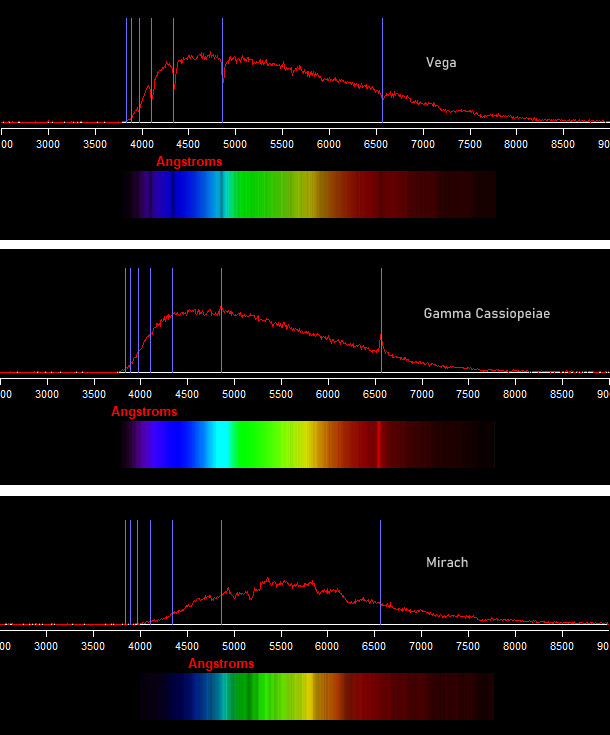
I left off the planetary nebula because it isn't a point-source image and would produce a badly
blurred graph. But the fact that I was able to take its spectrum tells me I can easily reach
ninth or tenth magnitude with this telescope, which in turn means that not only novae, but also
some supernovae in other galaxies are within its reach.
Permanent link to this entry


|
2019
October
24
|
Teaching a new dog old tricks
Using a planetary video camera to photograph a galaxy

By "teaching a new dog old tricks" I mean doing what I've done before, but with
different equipment. Last night I took spectra of several stars (which I'll
share with you in a day or two) and then decided to try using my
ASI 120MM-S
as an astrocamera.
This is a stack of six 45-second exposures of the galaxy M33 through my AT65EDQ telescope
(6.5-cm aperture, f/6.5) on my AVX mount with PEC enabled.
Not too bad. You can see some objects within the galaxy, especially a
nebula at the upper left.
I was using FireCapture 2.6 under Linux and made two blunders:
- I forgot to set it to 16-bit output (actually 12-bit with this camera),
so I didn't get the full bit depth of this camera.
- I didn't realize that when you take a series of exposures in FireCapture,
the first one recorded is actually what is already on the screen.
When the exposures are long, this becomes an issue.
I should have waited
for my first dark frame to finish capturing before I started recording.
As it is, I got one that wasn't dark, resulting in strange speckles in
the finished picture. Then I got everything sorted out and produced the
picture you see above.
I'll revisit this, of course. My question is whether I want a bigger camera
of a similar type — this one is only 1.2 megapixels.
Permanent link to this entry
Overpants
 When I was a child, I wondered why we didn't have a cold-weather garment that would slip
on over our trousers the way a jacket slips on over a shirt.
In fact, such things exist.
You can get them from RefrigiWear;
they're made in Georgia.
When I was a child, I wondered why we didn't have a cold-weather garment that would slip
on over our trousers the way a jacket slips on over a shirt.
In fact, such things exist.
You can get them from RefrigiWear;
they're made in Georgia.
You might think Georgia wouldn't be the best place for cold-weather gear, but actually,
many RefrigiWear products are worn by people who work inside meat lockers and other
large refrigerators. (As well as by Alaskan snow machine drivers, and so forth.)
These cold-weather trousers can be worn over regular trousers; if you plan to do that,
order them a size or two bigger than normal (and that's why RefrigiWear offers such
enormous sizes, up to 4XL).
I wore them during my observing session last night and was quite comfortable.
The temperature was 50 F. I know that if I were exercising hard, the same overpants
might be good down to 0 F or lower, but astronomy is an activity that doesn't
generate much body heat.
I also know that many people wouldn't wear anything special at 50 F, just a light jacket.
But I learned a number of years ago that the way to be comfortable while observing is to
overdress.
Your results may differ, of course.
Permanent link to this entry


|
2019
October
19
|
Centennial of RCA
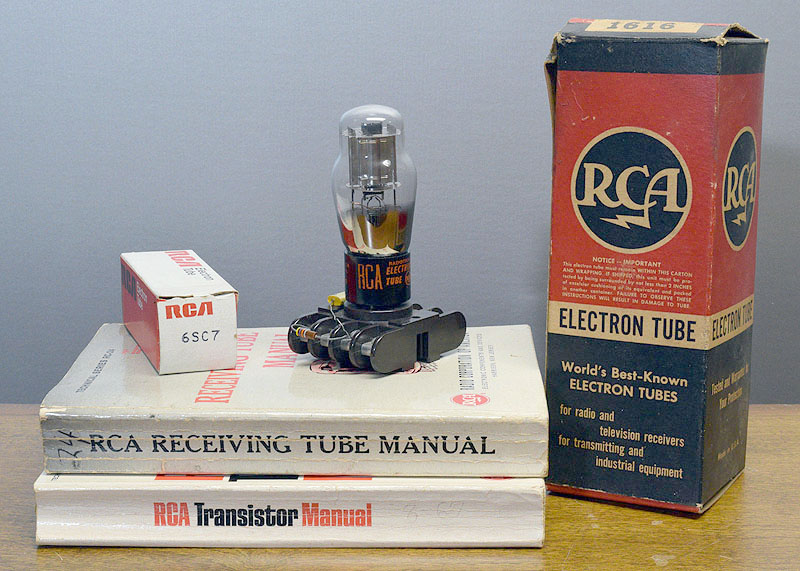
Although RCA is nowadays little more than a licensed trademark,
through most of the 20th Century it was almost synonymous with
electronics itself.
It's the company that brought radio, television, and record players
to Americans.
And, thanks to its excellent technical literature and generosity
in giving it out to curiosity-seekers, RCA played a major role in my
early learning about electronics.
In the picture you see RCA tube and transistor manuals, a tube from the 1970s
in a box with the post-1968 logo, a thyratron tube that I experimented with
in sixth grade, and a big tube box, about as old as me, that I bought at a
hamfest as a display piece.
The Radio Corporation of America was incorporated on October 19, 1919, to license
Marconi's patents so that radios could be built for our Navy by a purely
American company. Besides complete radios and TV sets, RCA made phonograph records
(having taken over Victor Talking Machine Company), record players, and lots of
innovative electronic parts. The best known of these were tubes (fastidiously
called electron tubes because not all contained vacuums — the thyratron
in the picture, for instance, contains hydrogen). But RCA also introduced a
number of semiconductors, including the 4000-series CMOS ICs that have been
used everywhere since the 1970s.
Perhaps RCA's biggest product, though, was information. They realized
early on that radio and TV wouldn't catch on unless technical information
and training materials were abundant. From early on, their tube and transistor
manuals contained lots of what would now be called "reference designs" —
and they got a reputation among ham radio operators for being good.
That is, their circuits were conservatively designed and worked well, and RCA
would tell you exactly how they worked.
Somehow, in the 1980s, despite one big and several small contributions to the
new world of digital electronics, RCA failed to keep up, and
after diversifying into unrelated business ventures, it dwindled away.
Some of us still miss it.
Permanent link to this entry


|
2019
October
18
|
No longer an Amazon Affiliate
For many years I've been an Amazon Associate or Affiliate, meaning than most
of the Amazon links on my web site (including the Daily Notebook) paid me a
small commission if people bought anything through them.
The income was tiny, maybe $30 a year.
Also, for a long time I have had this disclaimer at the bottom of every page:
I am an Amazon Associate, and almost all of my links to Amazon.com pay me a commission
if you make a purchase. This of course does not determine which items I recommend, since
I can get a commission on anything they sell.
A memo from Amazon today says this is no longer enough.
I'm not sure if it's Amazon's doing or that of the Federal Trade Commission,
but they now want me to put "Paid Link" or similar words on every link to Amazon,
not just a disclaimer at the bottom of the page.
That would require me to edit hundreds of existing pages. Yes, hundreds.
I've been blogging since 2004.
So, rather than edit the entire web site, I simply shut down the account, so that
those links no longer pay me a commission. They still go to the appropriate Amazon
products.
I understand why people reading product reviews need to know
if the reviewer stands to make money from sales of the product.
I'm entirely in favor of that.
In retrospect, Amazon's system bordered on being deceptive; if the affiliate
didn't post a disclaimer, or the reader happened not to find it, you had a potentially
deceptive situation.
So I have gladly gone along with the change.
I just don't think anybody thought about the large amounts of material on the Web that
were created in good faith before these rules were made.
I want to emphasize that I remain a satisfied Amazon customer and will continue
to recommend Amazon. And I know the editing could be done automatically,
but I would still have to tweak the layout manually. It's not worth the time it
would take.
I may rejoin Amazon Affiliates with a new code, so I can create new links
(properly labeled) that do pay me a commission. For now, though, the easiest solution
was to make all the existing ones become non-paying.
And I am experimenting with reactivating Google Ads, which I haven't used much
for a while. I may or may not stick with it.
I write the Daily Notebook as my own repository of information, not as a money-making
project. To make money I do AI research and development for businesses.
Permanent link to this entry


|
2019
October
17
(Extra)
|
XGecu TL866 II Plus universal programmer
Too cheap to be believed?
Back in August, I ordered a handful of Chinese-made electronic items,
trying to get some good deals before the trade war made things more
expensive or less available.
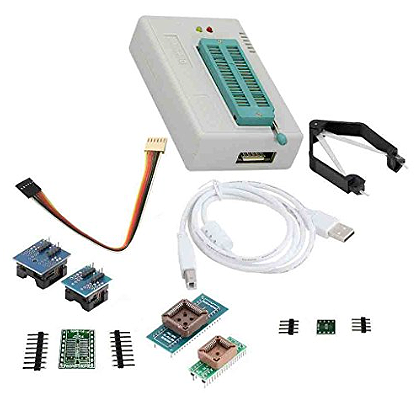
One of them was an XGecu TL866 II Plus universal device programmer, which
programs many types of microcontrollers and ROMs and also tests digital ICs.
By "programs" I mean it will write a HEX or BIN file onto a chip or read
the contents out to a HEX or BIN file on your computer; creating and
compiling the program is done with other software.
I bought mine from Amazon for under $60 delivered.
They still have them at that price.
And it stayed in the box until today, when I finally decided I needed to get it out
and test it, before all hope of returning a defective unit is gone.
Some background:
- This is not a $700 instrument, but it comes (reasonably) well recommended on forums.
It does a lot for the price. I'm going to use it for microcontrollers that I use only
occasionally and for which I don't have a better programmer. For example, it would have
spared me having to build a special jig for my PIC16F84A project a few months ago.
- The maker, Haikou Xingong Electronics Co., Ltd.,
also known as XGecu, also known as Autoelectric.cn,
apparently caters to the automotive market. Many people want to duplicate the ROMs or
microcontrollers that control car engines, or install modified code in them; relatively few
people actually create the code.
- Of course, the TL866 II has a lot more uses besides that. It even supports some
in-circuit serial programming protocols as well as programming in its 40-pin ZIF socket.
The only thing it won't do is program anything that requires a programming voltage
higher than 18 volts. That means some 30-year-old PROMs are out of reach, although newer
substitutes for them are just fine.
- The earlier TL866A and TL866CS were so widely counterfeited that the manufacturer took
them off the market. Since legitimate units had been sold under many names, there was a lot
of confusion, and, frankly, I'd expect a counterfeit one probably to be as reliable as the
original. (One thing a universal programmer can do is duplicate the chips in another
universal programmer!) But, of course, the legitimate developers should get the income.
Per Amazon's recommendation, I downloaded the latest software from the manufacturer,
and software is this gadget's weak spot, although it does the essential things
impressively.
What don't I like? Mainly strange unawareness that Windows is a multi-user operating
system and has definite places to install files.
That used to be an endemic problem in the microcontroller industry, but most of the
United States has grown out of it by now. Not China.
The software doesn't install in C:\Program Files. It wants to install
in D:\XGpro, but my drive D is a DVD drive. I couldn't put it in Program Files because
it has to be installed in a folder with write permission (and says so); nor could I put
it in my own Documents folder, for some reason I don't recall. (In both cases it
installed and then didn't work.) Further, it can't be uninstalled by doing anything
other than manually deleting all the files and the shortcuts.
I put it in C:\XGpro and it works. I have no idea if another user account on the same
machine would also be able to use it.
The other quirk of the software has to do with some of the lettering on the screen.
There is a font size problem, like this:
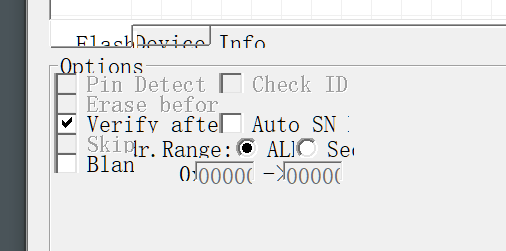
Only small areas of the display are affected. I wonder if the author relied on a font
that is not distributed with English-language versions of Windows.
Follow-up: To fix the problem at least partially, find XGpro.exe,
right-click, and choose Properties, Compatibility, Change High DPI Setting,
Override, System (Enhanced). However, I still think there is a missing font,
because when I choose Chinese or Russian as the language, I do not get the appropriate
characters on the screen.
Does it work?
Well, I read the code in an old PIC12F509A without problems, and I tested a 74HC373.
It worked fine. That's as far as I got.
It would take a lifetime to put this device through all its paces.
But I'm fairly confident that they did the essential things correctly and were
sloppy about less essential things, such as installation and user interface.
Permanent link to this entry


|
2019
October
17
|
Which of these is more multicultural?
Exotic characters in astronomical names
The latest Journal of the British Astronomical Association contains a letter
from me, proposing that the IAU's official names for astronomical objects should always
be written in the 26-letter alphabet with no diacritical marks or other special characters,
though a more decorated version of the name can be offered as an alternative.
I wrote it in response to a letter from Jean Meeus that cited asteroid names containing
African click marks and Polynesian long vowel marks.
My concern is that astronomers are not linguists, will not know for certain whether special
characters have been transcribed correctly or rendered into different fonts, and do not have
a ready source of information about exotic languages.
What's more, they have to make alphabetical lists, and how do you alphabetize a mark
improvised by a field linguist 50 years ago? Even if Unicode knows, people don't.
Accordingly, for the sake of international
communication, we need to confine ourselves to the alphabet that is on almost every keyboard
all over the world.
My purpose is to encourage multicultural naming. There's no reason astronomical names all
have to come from Greek and Roman mythology. But to use names from other sources, we have to
package them for usability.
In an online forum I got a counterargument (I don't know how serious) that by insisting on
the standard alphabet I was somehow supporting the evils of colonialism.
It is hard to know what such a person is wishing for (nor am I sure it was a serious argument;
he may just have wanted to see me knock it down, which I did by pointing out that his whole
argument was written in a colonialist language, namely English).
My goal is not to make English supreme, but rather to use the most widely available
set of alphabetic characters in the entire world, the ones that are on any keyboard that
uses any form of the Latin alphabet, and are supported by even the oldest software.
And if that's not multicultural, I don't know what is.
Permanent link to this entry
Using a UPS with medical equipment, lift chair, or CPAP

What if you want power-failure protection for something that is not a computer,
such as a small medical device; a lift chair or power recliner that would
be hard to get
out of without using its motor; or a CPAP machine?
You can use a computer UPS, but there are a couple of things to pay attention to.
First, some older and larger UPSes shut themselves off if no power is being drawn from
them at the time of the power failure. (They think the computer has shut down.)
This is a problem if you're in a lift chair,
which, of course draws no power when you're not moving it.
Then, power fails, and you push the button on the chair, expecting the UPS to power it,
and it doesn't. Bad news.
I observed that behavior in APC Back-UPS 500 units made 20 years ago, but not with the modern
Amazon Basics 400 VA UPS
that we're now using. If you have the problem, solutions include keeping a night light connected
to the UPS to provide a continuous load, or possibly hot-wiring a switch or button that will
wake up the UPS.
Second, you probably don't want the UPS to start beeping when power fails, especially if it's
on a machine that you use while sleeping, such as a CPAP. Usually, the beeper can be turned off.
For the Amazon unit I just described, the procedure is:
- Turn on the UPS by holding down the power button until you hear a long and a short beep.
- Then turn off the beeper by giving the button two brief presses (some experimentation will
be needed to find out how rapidly to do this). When successful, you will hear two short beeps.
I wrote these brief instructions on a label and attached it to the UPS.
A more heavy-handed tactic is to simply unsolder and remove the beeper. I've done that several
times in the past.
Last, know what to expect. The purpose of a UPS is not to get you through hours without electricity.
It's to get you through short power failures uninterrupted and keep longer ones from turning into
excessively difficult situations.
When there is a really long power failure, any UPS batteries that are getting old are likely to fail.
When power comes back, give all the UPSes 48 hours to charge up, then test them by unplugging them
from the wall. You'll probably find your batteries that are more than 3 years old aren't doing the job.
In fact, it's a good idea to replace UPS batteries every 3 years.
That implies writing the date on the UPS (on a label or piece of tape) when it's new
and whenever batteries are replaced.
One last thought. Some of the outlets on the UPS are only surge protected, not power failure protected.
Pay attention to the labeling, and if you're like me, put tape over the outlets that aren't UPSed,
to prevent unpleasant surprises.
Permanent link to this entry
Impenetrable alarm clock — bad user interface award
Today's Bad User Interface Award goes to my Sony ICF-C707 alarm clock.
Only with microprocessors is it possible to create an alarm clock that a highly
educated person cannot set or use without referring to instructions.
A hint: The first thing I discovered was that the
TIME SET buttons (two pairs) do not set the time. It went
downhill from there.
Bad software designers around 1980 relished every project as an opportunity to create
a new and challenging puzzle for the user.
But I thought that kind had all lost their jobs by now. Apparently not quite all.
While installing a UPS, I had to set up this clock from scratch.
For years previously, I had done little but turn the alarm on and off and change the
alarm time. The clock itself is very accurate.
Well, the procedure was impenetrable until I downloaded the instructions. Here's part of it;
could you have guessed any of this?

A "trap for young players" (as Dave Jones would say) is that many of the buttons have no
effect unless held down for 2 seconds. That made it extremely hard to learn anything by
just trying buttons.
This is not a self-setting clock. It doesn't pick up radio signals.
The only reason it wants to know the time zone is because
it had been set at the factory but did not know what part of the world it had arrived in.
From there, you get to a procedure whereby, with a long press of a hidden button on the back,
TIME SET will indeed set the time. (Starting with the year, so it can calculate Daylight
Saving Time dates.)
Now... I like the functionality of this clock... its great accuracy and automatic Daylight
Saving Time save me a lot of work. But why can't its controls be understandable to
people who haven't read the manual? Sony needs to think about how they are labeled and
what is shown on the screen. Why not display brief guidance on the screen itself?
Or even a few sentences saying what these buttons actually do, embossed in the bottom
of the plastic case?
I know there are those who will say, "Well, you should always read the instructions."
No. This isn't an exotic new machine, it's an alarm clock.
Just because they can make it hard to use, doesn't mean they should.
Permanent link to this entry


|
2019
October
16
(Extra)
|
Is this a circuit-design mistake?
High-voltage electrolytic capacitors in series
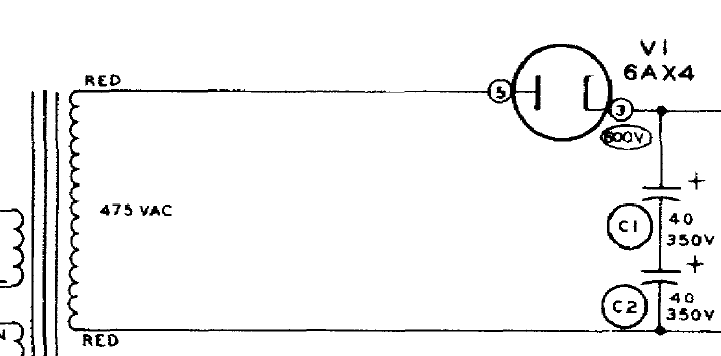
Since I still use my 50-year-old Heathkit IT-11 capacitor tester, mainly for
re-forming and for long leakage tests, I wanted to replace its most failure-prone
parts, the electrolytic filter capacitors, before they fail.
They could burst and make a real mess.
Above is the circuit design I found. It does something we're told not to do —
it puts two 350-volt electrolytic capacitors in series to handle 600 volts.
This is supposed to be risky because, if one capacitor becomes electrically leaky,
the other one will handle the whole voltage and be overloaded.
There are no 800-volt electrolytic capacitors.
I was all set to replace the pair with a
single 20-µF 1000-volt film capacitor
(something you can get in 2019 that they didn't have in 1969).
The correct value is 20 µF because two capacitors in series have half
as much capacitance as each one individually (strange but true).
But there wasn't room for that capacitor in the space available! Although electrically
ideal, and inexpensive, it's too bulky.
So I used two 47-µF, 450-volt electrolytics in series instead.
Was this a mistake?
Well, I started a conversation about the whole thing on
sci.electronics.design, one of the old Usenet unmoderated forums.
I got a very courteous reply from Winfield Hill
(co-author of The Art of Electronics) and helpful replies from a few
other people, but, of course, as is traditional on Usenet, some of them (not Mr. Hill!) fell to
quarreling and insulting each other.
The bottom line? Load-balancing resistors are not needed.
Capacitors can be put in series with no special arrangements.
There are a couple of reasons.
Modern electrolytic capacitors are extensively self-healing; that means that
leakage in well-made capacitors tends to stop on its own, as the leaky spot
heats up and (microscopically) becomes an insulator. And
leakage goes up more than linearly with voltage.
That means that if two capacitors in series leak unequally,
the leaky one will carry less voltage, causing it to leak less
(by a larger factor than just the voltage decrease),
and the system will self-stabilize.
The nonlinearity is documented in
this
Tadiran application note although they still advocate use of balancing resistors in
the traditional way.
Also, my capacitors are rated for 450 volts each, and handling 600 total, so
quite a bit of imbalance could occur without pushing them past their limits.
Permanent link to this entry
The October 15 crunch
Have you noticed that important activities are scheduled as close to
October 15 as possible, every year, everywhere?
Permanent link to this entry


|
2019
October
16
|
Has the earth shifted?
At last, some fake news that isn't political.
A web page reports that
according to Inuit elders (Alaskan natives),
"the Earth has 'wobbled' or shifted, and that their sky is changed.
The elders claim that the sun does not rise from the same position as before.
Moreover, the day is longer and the sun is positioned much higher than before."
I haven't heard this from any reliable source and assume it is a complete hoax.
The article's assertion that NASA scientists are "very concerned" more or less proves nobody
talked to a NASA scientist.
Apparently the writer of the story doesn't realize astronomers observe the sky all the time
and have to be able to find things in it. Even a tiny shift would be noticed by the people
who aim telescopes (using computers or, in earlier times, setting circles with angles marked on them).
And sailors navigating with sextants would notice a shift of even a small fraction of a degree.
Actually, quite a bit of astronomy is devoted to precise position measurement. One of the most
sensitive tests is a solar eclipse — if the earth had shifted, the moon's shadow wouldn't hit
the earth in the predicted place. Similar measurements, of the moon passing in front of stars rather than
the sun, are made frequently.
Finally, the sun rises and sets on time, as calculated with formulae that were last refined in
Victorian times and haven't changed substantially for two thousand years.
If it isn't a hoax after all, I can think of two things that might have happened.
Maybe an Inuit elder is comparing the sky today with a detailed description that is several
centuries old. Such things are handed down even in societies that lack writing.
In that case, maybe he has noticed precession. That is a well-understood slow change in
the earth's axis that was known in ancient Greek times and has been well understood for centuries.
It is why most of the ancient Greek constellation Centaurus, for example, is no longer visible
from Greece. But precession does not affect sunrise and sunset.
Or maybe he and his people have simply moved to a different latitude. That is the
easiest way to make the sun rise and set at the wrong times and change the length of the day.
A traditional description of the sky for one latitude won't fit another, even just a few hundred
miles north or south.
Permanent link to this entry
Two farewells
I must also bid farewell to James D. Hall, D.D.S., who was my dentist when I first
came to Athens (1973). His son, Brian P. Hall, D.M.D., has been my dentist ever since he
took over the practice.
And I lament the imminent closing of the Athens Sears store, soon to be followed by the collapse
of Sears, Roebuck & Co. as a whole.
Sears tool departments have been important to me ever since my father took me to the one in
Valdosta regularly around 1965. They've looked about the same for more than 50 years (with more
red in the color scheme in later years). Sears' insight was that even in small towns,
people buy specialized tools; that was where I saw micrometers, plumb bobs, and other unusual things.
In 1994 I bought a Sears 8-inch table saw, not quite realizing it was the last incarnation of a very
early product; it still serves me well and is much quieter than most table saws.
Here's what was left in Athens a few weeks ago. It has dwindled much further. Sadly, many of
the prices are only discounted 30%, which doesn't make them compelling; Sears had gotten pricey
in recent years. I don't know how much longer the store will stay open, or how much longer
there will be Sears stores anywhere. See
also my earlier note.

Permanent link to this entry


|
2019
October
7
|
Edward Van Peenen II, 1940-2019

Word has reached me that one of my early mentors has died.
When I was in 7th to 9th grades, 1968-71, Edward Van Peenen helped me use laboratories,
the observatory, and the planetarium at Valdosta State College, where he taught physics.
This was my first extended acquaintance with a professional scientist, and it was instrumental
in launching my academic career.
To see his Valdosta obituary, click here.
The color picture above was taken in 1976, when, on a visit to Valdosta, I encountered him
bicycling through the town in his usual way. I last saw him in 1985, and my understanding is
that by minimizing his cost of living, he had been able to retire in his forties and continue
living the solitary, orderly life that he preferred.
May his memory be eternal.
Permanent link to this entry


|
2019
October
6
|
When to discard old but unused electrolytic capacitors
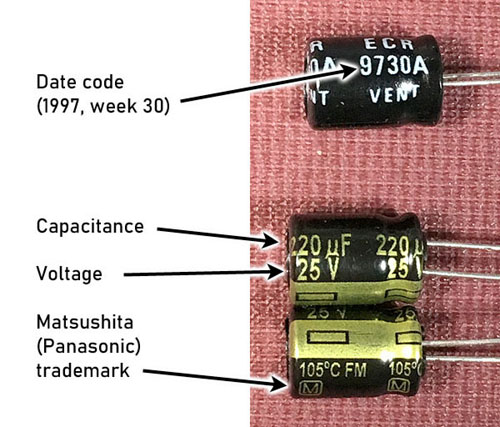
Semiconductors and resistors last forever when not used, but electrolytic capacitors
deteriorate with non-use. How fast? Should I throw away my old ones?
It used to be standard practice for repair shops to throw them away after two years on the shelf.
The question that came up while I was cleaning up and modernizing my electronics lab.
I asked it on two electronics forums and got very divergent answers.
So I did some of my own testing.
What follows is a ramble through a lot of information, some of it uncertain.
First, some background facts:
-
Many of us have 50-year-old equipment that still works with its original capacitors.
The catch is, it hasn't been sitting unused for 50 years. Even charging a capacitor
once every 5 years will greatly extend its life.
-
Electrolytic capacitors aren't used as much as they used to be. Nowadays they're used
almost exclusively for power-supply filtering. Those big audio coupling capacitors have
been superseded by op-amp circuitry, and large capacitors in RC timing circuits have been
superseded by digital counters. Even for power supply filtering, there are now 20- and 30-microfarad
film capacitors.
-
In the industry, electrolytics are not sold as fresh if they are more than about 3 years old.
Since the new equipment built with them also has to have a shelf life, I figure they're actually
good for maybe 6 to 10 more years, at least, and this agrees with the specifications I can find,
which are short and vague.
-
Of course, you're not going to find measured 10-year reliability for what's being made now;
improvements to the process and materials come along every few years. At best, you'll find
accelerated aging tests. 1000 hours at 105 C are comparable to 30 years or more at room temperature,
depending your preferred version of Arrhenius'
equation and the fact that at 105 C, the capacitor is at its thermal limits and experiencing
a stress it would not experience at room temperature no matter how much time went by.
And if the process and materials are continuing to improve, that's actually another reason to
distrust old capacitors — not only have they aged, they weren't as well-built in the first place.
-
Some of the best electrolytics now have no date codes, or at least none in the conventional
format. That suggests they may have a longer shelf life than the manufacturers
actually want to announce, when they are
stored at the factory or distributor
under controlled conditions.
Unfortunately, dirt-cheap electrolytics also often lack date codes so they can be sold forever...
-
The industry became afraid of cheaply made electrolytics when
a lot of computers failed around 2003-2006 and the problem was
traced to cheap manufacturing based on a mis-copied stolen formula.
(Strange but true. I'm not making this up!) Nowadays, premium brands such
as Panasonic, Cornell-Dubilier, Nichicon, and Rubycon are highly respected.
-
Good electrolytics no longer cost much, partly because of a better supply chain.
Instead of $2 at Radio Shack, think 20 cents at Digi-Key or Mouser.
I faced a cost of about $15 to completely restock — which I gladly paid —
one bad capacitor would cost me more than that in time and frustration.
With all that in mind,
I tested about thirty capacitors of various ages. Here is what I now believe, based
on those tests:
- Deterioration of old capacitors is slow and unpredictable. Basically, the percentage of bad
ones goes up gradually. I have a lot of vintage-1997 capacitors (22 years old),
and most of them pass all tests (after re-forming) as if they were new. A percentage of them do not,
and that percentage increases with age. Individual capacitors deteriorate suddenly, while others,
the same age, don't show any aging effects.
- Leakage (electrical) is the most valuable test for old-but-unused capacitors. The deteriorating ones
have much more leakage than the healthy ones. The capacitance and ESR don't change much.
ESR and capacitance testing are for capacitors that may have deteriorated in use.
To test leakage, connect 4 things in series: an adjustable power supply (set to the rated voltage of
the capacitor), a microammeter, a 1k resistor, and the capacitor itself.
You'll see a burst of high current as the capacitor charges, and then, if the capacitor is
fresh, the current will settle down within about a minute. If the capacitor is older, it will drop
more slowly and
continue to improve for as much as an hour or two. Re-forming the capacitor in this way
is important whenever you use an older capacitor. It renews the electrolytic layers.
When doing an important repair with a capacitor that has been in stock for a few years,
it is appropriate to re-form it for a whole hour.
-
Many capacitors perform much better than specified. For example, Panasonic says that
on low-voltage capacitors (100 V or less), maximum leakage is 3 µA or 0.01×C×V, whichever is larger.
That means a 100-µF, 20-volt capacitor can leak 20 µA. I seldom saw that much, even in older
capacitors; 5 µA was more typical.
-
In my experience, brand is a better predictor of bad capacitors than age.
Many capacitors, even major brands, no longer have date codes.
But if a capacitor looks old, grungy, or untrustworthy, it is untrustworthy.
The most unreliable batch of capacitors that I've encountered was a cheap assortment
marketed to hobbyists.
So the bottom line? My current practice is to freely use capacitors up to 10 years old,
use them with caution up to 20 or 25 years old, and distrust those that are older.
There is certainly no need to toss them when they're just 2 or 3 years old. But note that their
appearance has not changed much, and capacitors from the 1980s may look just like new ones
if you don't look too closely.
I expect people to write in and tell me I'm wrong.
But I expect to be told I'm wrong in both directions (too cautious or not cautious enough),
so it will balance out.
Permanent link to this entry


|
2019
October
5
|
Happy birthday, Melody!
Happy birthday, Melody! And thank you for bringing us some mild weather.
100 F on the 3rd, 99 F on the 4th, and 75 F today. How did you do it?
Permanent link to this entry
Impeachment is not a football game
Time out for some political advice. Expanding on what I said on Facebook:
Impeachment of the President is not a football game.
You are not supposed to pick a side in advance and cheer for it unconditionally.
What is going on right now is fact-finding, and you should be ready to adjust
your opinion in response to the facts that come out.
I see people doing several unreasonable things:
(1) Making up a story in which their side wins, and believing the made-up
story rather than paying attention to reality.
(2) Simply refusing to believe facts that don't support their side, especially
if some guy somewhere — quoted somewhere in the news media — makes
the same refusal. To a person in this state of mind, one person with a fringe opinion
outvotes a hundred who are well-informed.
(3) Assuming that one side can do no good and the other side can do no wrong,
or that the slightest hint of wrongdoing on one side makes everything on that side
entirely worthless.
Do not be like them.
If you actually have enough information to know for sure how the impeachment
investigation should come out, you shouldn't be posting on Facebook — you should
be testifying before Congress.
Permanent link to this entry


|
2019
October
4
|
Happy July 96th!
We have started giving the date as July 96th rather than October 4th
because July's weather never stopped.
October 3 was the hottest October day Athens, Georgia, has ever had,
with a high of 100 F. Today is supposed to be the last day of it,
thank goodness.
The night sky has been clear with scattered clouds, an odd combination,
but last night I grabbed a quick shot of Jupiter next to the moon, and
the bright satellites of Jupiter in a straight diagonal line.
The bright side of the moon is very overexposed; you can see the
earthlit side. You can also see a few stars; leaves and branches
of a tree; and a lot of streaks and glare
from reflections and diffraction in my lens.

Canon 60Da, ISO 400, Sigma 105/2.8 DG EX lens, 1 second at f/4 on a
fixed tripod.
Permanent link to this entry


|
|
|
This is a private web page,
not hosted or sponsored by the University of Georgia.
Copyright 2019 Michael A. Covington.
Caching by search engines is permitted.
To go to the latest entry every day, bookmark
http://www.covingtoninnovations.com/michael/blog/Default.asp
and if you get the previous month, tell your browser to refresh.
Portrait at top of page by Sharon Covington.
This web site has never collected personal information
and is not affected by GDPR.
Google Ads may use cookies to manage the rotation of ads,
but those cookies are not made available to Covington Innovations.
No personal information is collected or stored by Covington Innovations, and never has been.
This web site is based and served entirely in the United States.
In compliance with U.S. FTC guidelines,
I am glad to point out that unless explicitly
indicated, I do not receive substantial payments, free merchandise, or other remuneration
for reviewing or mentioning products on this web site.
Any remuneration valued at more than about $10 will always be mentioned here,
and in any case my writing about products and dealers is always truthful.
Reviewed
products are usually things I purchased for my own use, or occasionally items
lent to me briefly by manufacturers and described as such.
I am no longer an Amazon Associate, and links to Amazon
no longer pay me a commission for purchases,
even if they still have my code in them.
|
|























